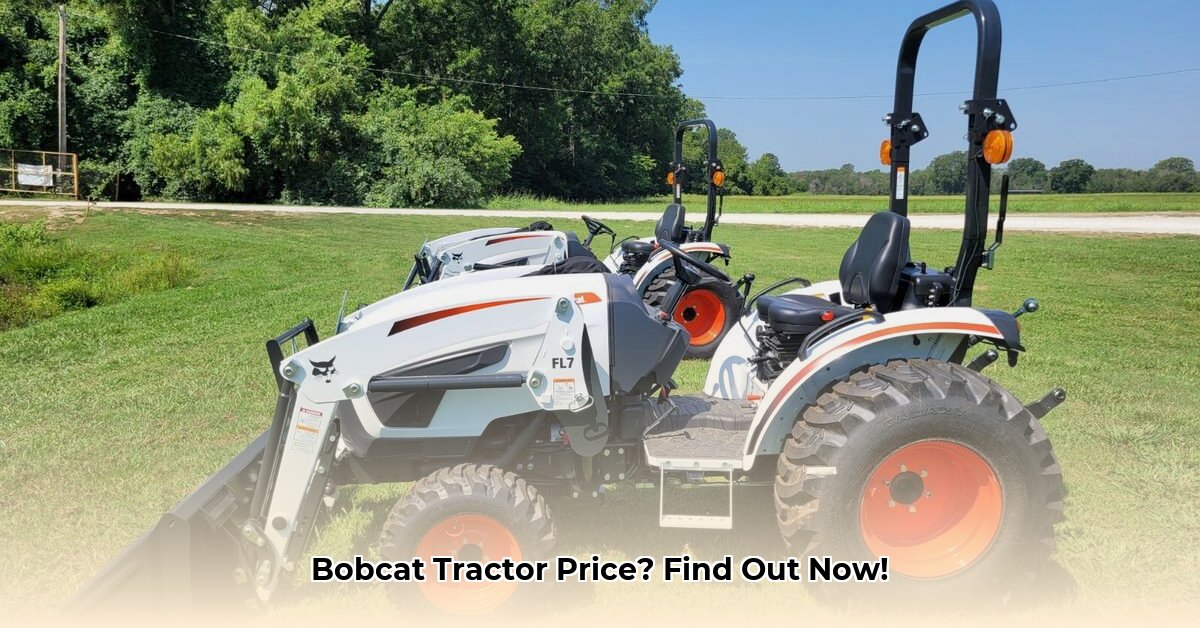
Thinking about investing in a Bobcat tractor for your farm? Understanding the true cost is crucial for long-term success. This guide breaks down Bobcat tractor pricing, financing options, operational costs, and sustainability considerations to help you make an informed decision. We'll also compare Bobcat to competitors like John Deere, Kubota, and New Holland. For more on tractor pricing in general, check out this helpful resource on tractor costs.
Understanding Bobcat Tractor Prices
The price of a new Bobcat tractor typically ranges from $20,000 to $60,000. This wide range reflects several key factors:
- Horsepower: More powerful tractors cost more.
- Features: Advanced features increase the price.
- Size: Larger tractors designed for heavier tasks command higher prices.
- Location: Dealer pricing varies geographically.
Used Bobcat tractors offer significant savings, often 20% to 40% less than new models. However, condition and location significantly affect the final price.
Financing Your Bobcat Tractor
Financing is often necessary for such a large purchase. Several options exist:
- Farm Equipment Loans: Many lenders offer loans with competitive Annual Percentage Rates (APRs), allowing you to pay over a set period.
- Leasing: Leasing provides flexibility, particularly for shorter-term needs.
Consult a financial advisor to determine the best financing strategy for your specific circumstances.
Bobcat vs. the Competition
Bobcat often offers a competitive initial price point. However, a comprehensive comparison requires examining:
- Initial Price: Bobcat typically offers lower initial prices than John Deere, Kubota, and New Holland.
- Dealer Network: The extent of the dealer network influences parts availability and service support. Bobcat's network may be less extensive in certain regions.
- Parts Availability: Easily accessible parts are crucial for minimizing downtime.
- Long-Term Support: Consistent dealer support is vital for long-term reliability and reduced maintenance costs. This often favors established brands like John Deere and Kubota.
- Resale Value: Brand reputation impacts resale value.
Total Cost of Ownership (TCO)
The initial purchase price is only part of the equation. TCO considers:
- Purchase Price: The initial cost of the tractor.
- Financing Costs: Interest payments (if applicable).
- Maintenance: Regular servicing and repairs.
- Fuel Costs: Operating costs, influenced by engine efficiency and usage.
- Depreciation: The decline in value over time.
Careful TCO analysis is crucial for determining the true long-term cost of ownership. Tools and spreadsheets are available to assist with these calculations.
Sustainability Considerations
While Bobcat may not publicly publish extensive data on fuel efficiency and emissions for all models, this is a critical aspect for environmentally-conscious farmers. Independent research is vital to assess the environmental impact before making a purchase. Contacting Bobcat directly for specific model data is highly recommended. Comparing fuel efficiency and emission data with competitors is also a crucial step in responsible purchasing.
Actionable Steps for Different Stakeholders
The following guide provides actionable steps for various stakeholders:
Small-Scale Farmers
- Explore Used Tractors: Consider used tractors to reduce initial costs.
- Utilize Financing: Explore financing options to manage payments.
- Prioritize Smaller Models: Start with a smaller model suitable to your needs.
- Monitor Costs: Track all expenses carefully.
- Consider Group Buying: Explore potential cost savings through group purchasing options.
Large-Scale Farms
- Obtain Multiple Quotes: Gather quotes from several dealers for thorough price comparison.
- Analyze Operational Needs: Determine your specific needs, such as horsepower and attachment compatibility.
- Invest in Service Contracts: Consider service contracts for predictable maintenance costs.
- Implement Preventative Maintenance: Establish a robust preventative maintenance program to extend lifespan and reduce unexpected costs.
- Utilize Technology: Explore telematics and other technological solutions for optimizing performance and minimizing downtime.
Equipment Dealers
- Offer Transparent Pricing: Provide clear, transparent pricing information for all models, including optional features.
- Promote TCO Analysis: Provide resources to help customers analyze total cost of ownership.
- Highlight Sustainability: Emphasize sustainability features and data for environmentally conscious farmers.
- Invest in Training: Provide thorough training on equipment operation and maintenance.
- Build Strong Customer Relationships: Foster strong relationships with customers to improve loyalty and referral business.
Policymakers
- Promote Sustainable Practices: Encourage the adoption of sustainable agricultural practices through policies and incentives.
- Support Farm Technology: Invest in research and development of technologies for improving farm efficiency and sustainability.
- Invest in Rural Infrastructure: Improve rural infrastructure, including access to high-speed internet and reliable energy sources.
- Develop Clear Emission Standards: Implement clear and well-defined emission standards.
- Offer Financial Incentives: Offer financial incentives for farmers adopting sustainable technologies.
Risk Assessment and Mitigation
| Risk Factor | Likelihood | Impact | Mitigation |
|---|---|---|---|
| High Purchase Price | High | High | Explore financing, consider used equipment, and seek seasonal discounts. |
| Unexpected Repair Costs | Medium | Medium | Preventative maintenance, extended warranties. |
| Equipment Malfunction | Low | High | Choose reputable dealers, invest in warranties, use telematics for predictive maintenance. |
| Obsolescence | Low | Medium | Invest in models with long-term support and proven reliability. |
| Environmental Regulations | Medium | Medium | Thorough research of fuel efficiency and emissions data; prioritize sustainable models. |
Navigating Regulatory Implications
Stay informed about emission regulations in your region, as these significantly influence purchasing decisions and operating costs. Changes in legislation can impact tractor choices; therefore, ongoing awareness of regulatory updates is crucial.
Conclusion
Choosing a Bobcat tractor involves careful consideration of initial cost, financing, TCO, and sustainability. By carefully weighing these factors and comparing Bobcat to competitors, you can make an informed decision that aligns with your farm's needs and contributes to sustainable agricultural practices. Remember to conduct thorough research and seek expert advice to ensure a successful investment.